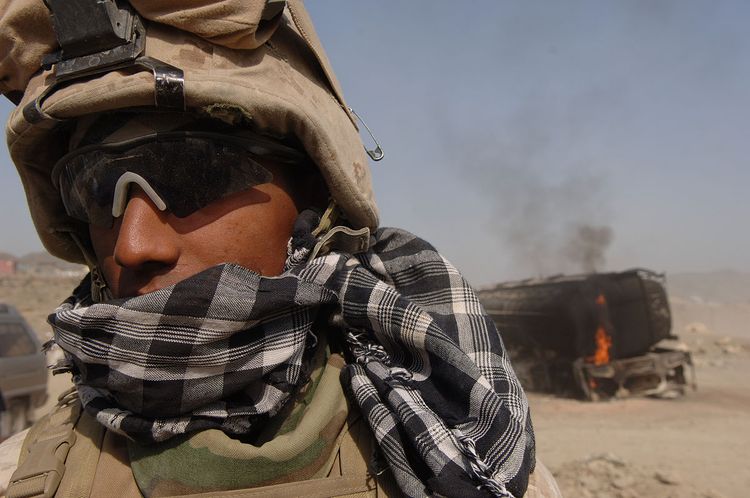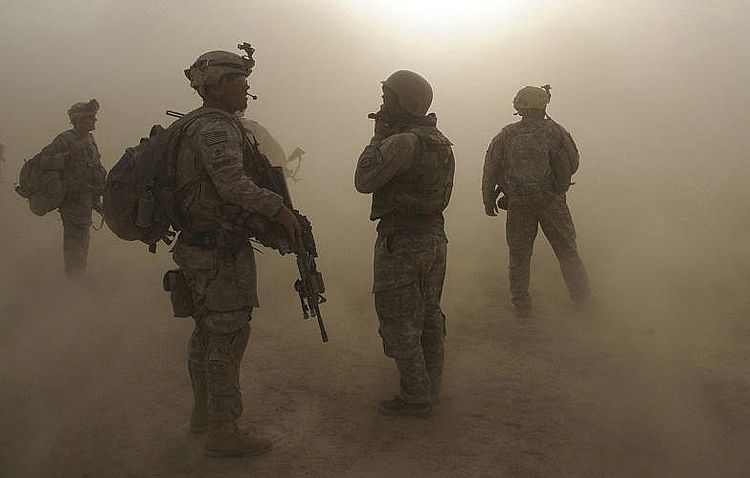U.S. military shemagh use in a hypothetical scenario: You’re on an operation at dusk in the Middle Eastern desert, taking heavy enemy fire. The sun blazes red on the western horizon as you lay down cover fire for two other guys in the unit engaged in a flanking maneuver.
At stake is a cache of maps and documents that could swing the tide of the campaign. But then the assault on your position stops. The enemy bugs out. Why? That sunset is now blotted out by a massive approaching sandstorm. You look at the guy next to you. No shemagh. As you tie yours around your face and reposition your ballistic goggles, you shake your head. The other guy’s gonna be spitting mud in a matter of minutes.

What is a Shemagh?
These versatile head scarves have been worn both by soldiers and by civilians in desert regions for centuries. The typical shemagh is a square piece of cotton or other cloth, 42 inches on a side. That’s three and a half feet, about the length of your typical guitar. The better quality shemaghs have a woven pattern — that is, they’re made of threads of multiple colors, unlike printed-pattern shemaghs, which don’t breathe as well.
The shemagh (pronounced “shh-mog“) when tied in the traditional manner around the face protects against blowing sand and dust, which of course is commonplace in places like Afghanistan and Northern Africa. But more than that, it can be used as a towel, torn-off strips can be used as tinder for a fire, the shemagh can serve as a small blanket, it can be a sling for someone who’s injured their arm, the list goes on and on.
And the regional names for the shemagh are nearly as numerous. Here’s what the head wrap is known as elsewhere:
- Iran: chafiye
- Iraq: ghutra
- Palestine: keffiyeh
- North Africa: rezza
- Kurdistan: cemedani
If you are in the market for one, read our thorough guide on where to buy the best types of shemaghs.
Can You Wear a Shemagh in the U.S. Military?
There’s no such thing as a “U.S. military shemagh,” per se, although several online shopping sites frequented by servicemen offer them for sale. A preponderance of American troops, especially Special Forces units, use shemaghs when deployed to desert areas, but the shemagh is not currently standard issue.
It is standard issue for the armed forces of the U.K., and that stems from ground soldiers during World War II observing the local dress when they went to fight in the North African campaign, and following suit. Since then, servicemen in armies all over the world have used the shemagh not only for the uses listed above, but also as a means to protect gear from the elements, as a first-aid cloth to slow the flow of blood, and as supplemental camouflage.
Why do U.S. Soldiers Wear a Shemagh?
In today’s desert operations, more often than not, a soldier will don the versatile cloth, just because it makes life in arid regions easier. And specific stories have come out of the U.S. military’s recent desert experience. For example former U.S. Army Paratrooper Eric Tang tells of how his platoon became aware of a major Al Qaeda training and bomb-making operation going on in a series of caves in Afghanistan.
The resulting plan of attack included deploying air forces before sending in ground troops to defuse any bombs and conduct SSE — sensitive site exploitation, basically a search for sensitive enemy documents, plans, maps, etc.
The week before the mission, while we were still observing the area [and] planning how to best execute the mission, one of the crusty sergeants told his team leaders to wear and bring their shemaghs. One, it would help during the brownout for the infil. Two, it’ll help cover up the smell of the dead.
Note: in this case, “brownout” refers to dust in the air, not a drop-off in electricity availability.

Non-Military Shemagh Uses
As it turns out, for every U.S. military shemagh in use today, there are three or four worn for purposes of fashion and comfort. Some good examples of exactly how, can be found in our SHTF Blog article about shemagh styles. We have it on good authority — some of us remember — that the shemagh became a regular fashion accessory in the United States beginning in the late 80s.
More recently, in the early 2000s there was a trend among Japanese youth that had them wearing shemaghs with camouflage clothing. And that’s not even mentioning the thousands of cowhands, ranchers, and farmers who have adopted the shemagh as a dust filter that’s superior to the old bandanna over the nose technique.
Conclusion – How to Tie Your Military Shemagh
So there you have it: a simple cloth square, the shemagh, traveling through history from the necks of simple arid-land farmers and nomads to a tactical piece of gear worn by U.S. Special Forces when the chips are down. I’ve given you the basics, but one thing remains: how to tie your shemagh.
Watch the video below, and keep those nostrils clear!